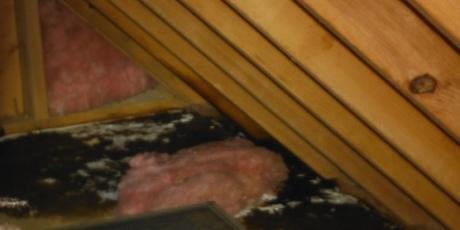
“When we walked into the upstairs bathroom, there was a strong mildew odor and it was evident that the homeowners were experiencing problems keeping the bathroom dry. The problem was an unvented bathroom exhaust fan. The attic was also affected, as there were signs of mold on the roof deck above the bathroom. We ended up having to just vent the bathroom fan to the exterior, which is a pretty common solution to the issue.”– Kevin Love, Orange Energy Solutions Building Analyst at a home in Glenside, PA.
Does this issue sound familiar to you? Moisture issues within the home are not a matter to be taken lightly, as moisture in one area of the house could be causing mold growth and damage in an entirely different part of the house. Aside from causing mold growth, water can erode and damage parts of your home over time, compromising your home’s structural integrity. Below are some examples of common moisture issues the Orange Energy Solutions team has encountered over the years and what this section of the audit report will typically look like.
Problem: An Unvented Bathroom Exhaust Fan

The image to the left shows an attic space where a bathroom vent is exhausted to the exterior, but instead stops in the attic and is therefore expelling warm, moist air into the attic space. This means the attic is now a perfect environment for mold growth and water damage. The vent needs to be extended through the attic space and exhausted to the exterior to allow moist air from the bathroom to escape to the outside.
 Problem: An Unvented Dryer Exhaust
Problem: An Unvented Dryer Exhaust
An improperly vented dryer exhaust can potentially cause moisture problems and can affect your home’s air quality by outputting moisture and some dust or lint from the dryer into your home. A properly vented dryer exhaust, pictured here, is pulling that warm dryer air through the basement window and to the outside.
Problem: A Leaking Roof

Roof leaks can cause many health and safety issues in your home: mold growth, mildew, and deterioration of building material. The building analyst will inspect the attic cavity for any evident roof leaks and any sign of mold growth or other water-related dangers. The leak must be fixed, the area freed of damaged material and/or mold, and re-insulated and air sealed per your home’s requirements.
 Problem: A Broken or Disconnected Down Spout
Problem: A Broken or Disconnected Down Spout
When a gutter or downspout is improperly connected or broken, water may be entering your home through the external wall from which the gutter has been disconnected. Luckily, gutter and downspout replacement or repair is simple. Mold remediation within the wall, however, is a more involved process, but an incredibly important one. Our building analysts are keen observers of water infiltration and will be able to detect even seemingly invisible water damage within the wall cavity.
Checking your home for water damage is one of the most important items on the energy assessment checklist, and something our team takes very seriously! Contact us today to schedule your energy audit.
